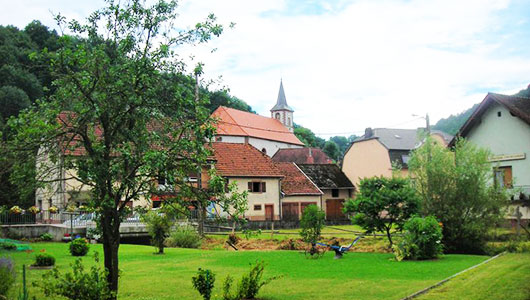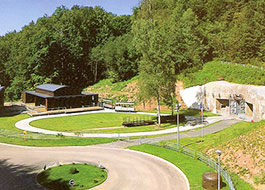Siersthal
Durée visite : 60 min
Moyen : parking de proximité
re
Siersthal est mentionné en 1356 sous la forme Sigersthal, du nom d’homme germanique Sigiher et du substantif Thal, de l’allemand Tal, la vallée. Au début du XVIe siècle, une verrerie est fondée à Holbach par le comte Jacques de Deux-Ponts-Bitche. Abandonnée en 1585, elle est relayée l’année suivante par la verrerie de Münzthal, berceau de la verrerie de Saint-Louis-lès-Bitche. Du point de vue spirituel, Siersthal est paroisse de l’archiprêtré de Hornbach jusqu’en 1802 avec quatre succursales, puis est passé dans celui de Rohrbach-lès-Bitche. Du point de vue administratif, de 1790 à 1802, le village est commune de l’éphémère canton de Lemberg puis entre dans celui de Bitche. C’est à Siersthal, tout près de l’église, que dans les années 1770, le Père Dominique Lacombe, ami du Père Jean-Marie Moye, fonde une école de formation, pour les religieuses enseignantes de la Providence de Saint-Jean-de-Bassel. À deux kilomètres de là, sur le Wasenberg dominant Holbach, la chapelle Notre-Dame-de-Fatima, constitue de nos jours un haut-lieu spirituel du Bitcherland, but d’un important pèlerinage marial.
Siersthal is mentioned in 1356 under the form Sigersthal, from the Germanic man’s name Sigiher and from the substantive Thal, from the German Tal, the valley. At the beginning of the 16th century, a glass factory was founded in Holbach by Count Jacques de Deux-Ponts-Bitche. Abandoned in 1585, it was taken over the following year by the Münzthal glassworks, cradle of the Saint-Louis-lès-Bitche glassworks. From a spiritual point of view, Siersthal was the parish of the archpriest of Hornbach until 1802 with four branches, then moved to that of Rohrbach-lès-Bitche. From an administrative point of view, from 1790 to 1802, the village was part of the ephemeral canton of Lemberg, then entered that of Bitche. It was in Siersthal, very close to the church, that in the 1770s, Father Dominique Lacombe, friend of Father Jean-Marie Moye, founded a training school for the teaching nuns of the Providence of Saint-Jean- de-Bassel. Two kilometers away, on the Wasenberg dominating Holbach, the Notre-Dame-de-Fatima chapel is nowadays a spiritual high place of Bitcherland, the goal of an important Marian pilgrimage.
Siersthal wird 1356 unter der Form Sigersthal erwähnt, vom germanischen Mann Sigiher und vom substantiven Thal, vom deutschen Tal, dem Tal. Zu Beginn des 16. Jahrhunderts wurde in Holbach vom Grafen Jacques de Deux-Ponts-Bitche eine Glasfabrik gegründet. 1585 aufgegeben, wurde es im folgenden Jahr von der Glashütte Münzthal, der Wiege der Glashütte Saint-Louis-lès-Bitche, übernommen. Aus spiritueller Sicht war Siersthal bis 1802 die Pfarrei des Erzpriesters von Hornbach mit vier Zweigen und zog dann nach Rohrbach-lès-Bitche. Aus administrativer Sicht war das Dorf von 1790 bis 1802 Teil des kurzlebigen Kantons Lemberg und trat dann in den von Bitche ein. In Siersthal, ganz in der Nähe der Kirche, gründete Pater Dominique Lacombe, Freund von Pater Jean-Marie Moye, in den 1770er Jahren eine Ausbildungsschule für die unterrichtenden Nonnen der Vorsehung von Saint-Jean- de-Bassel. Zwei Kilometer entfernt, auf dem Wasenberg, der Holbach dominiert, ist die Kapelle Notre-Dame-de-Fatima heute ein spiritueller Höhepunkt des Bitcherlandes, das Ziel einer wichtigen marianischen Pilgerreise.

Coupé d’or à la bande de gueules chargée de trois alérions d’argent. et de gueules au lion léopardé d’or.
Armes de Lorraine avec le lion de saint Marc, patron de l’église.
Arms of Lorraine with the lion of Saint Mark, patron of the church.
Wappen Lothringens mit dem Löwen des Heiligen Markus, dem Schutzpatron der Kirche.

Die Beseknipper (Besenbinder) = les faiseurs de balais.
Au dernier siècle, il y avait dans cette localité plusieurs familles d’origine nomade qui confectionnaient des balais avec des touffes de bruyère ou des menus rameaux de bouleau, liés ensemble au bout d’un bâton. Vers 1850, les faiseurs de balais figuraient parmi les types populaires de la rue. Mais leur métier était fort décrié et caricaturé, car les hommes avaient la réputation d’être des fainéants, des ivrognes et des bons à rien.
Die Beseknipper (Besenbinder) = the broom makers.
In the last century, there were in this locality several families of nomadic origin who made brooms with tufts of heather or small birch branches, tied together at the end of a stick. Around 1850, broom makers were among the popular types on the streets. But their profession was much disparaged and caricatured, because the men had the reputation of being lazy, drunkards and good-for-nothing.
Die Beseknipper (Besenbinder) = die Besenmacher.
Im letzten Jahrhundert gab es an dieser Stelle mehrere Familien nomadischer Herkunft, die Besen mit Heidebüscheln oder kleinen Birkenzweigen herstellten, die am Ende eines Stocks zusammengebunden waren. Um 1850 gehörten Besenmacher zu den beliebtesten Typen auf den Straßen. Aber ihr Beruf war sehr herabgesetzt und karikiert, weil die Männer den Ruf hatten, faul, betrunken und nichtsnutzig zu sein.

Les habitants et les habitantes de la commune de Siersthal s’appellent les Siersthalois et les Siersthaloises.
The inhabitants of the commune of Siersthal are called the Siersthalois and the Siersthaloises.
Die Bewohner der Gemeinde Siersthal heißen Siersthalois und Siersthaloises.
Les points de visites
.
L’ouvrage est composé en surface de huit blocs de combat (regroupés en deux demi-ouvrages : blocs 1, 2 et 5 à l’ouest, blocs 7 et 8 au milieu, blocs 3, 4 et 6 à l’est) et de deux blocs d’entrée, avec en souterrain une caserne, une cuisine, des latrines, un poste de secours, des PC, des stocks d’eau, de gazole et de nourriture, des magasins à munitions (un M 1 et plusieurs M 2) et une usine électrique, le tout relié par des galeries profondément enterrées. L’énergie est fournie par quatre groupes électrogènes, composés chacun d’un moteur Diesel Sulzer 6 DD 22 (à six cylindres de 7 040 cm3 de cylindrée chacun, fournissant 240 ch à 500 tr/min) couplé à un alternateur, complétés par un petit groupe auxiliaire, servant à l’éclairage d’urgence de l’usine et au démarrage pneumatique des gros diesels. Le refroidissement des moteurs se fait par circulation d’eau.
The structure is composed on the surface of eight combat blocks (grouped into two half-structures: blocks 1, 2 and 5 in the west, blocks 7 and 8 in the middle, blocks 3, 4 and 6 in the east) and two entrance blocks, with underground barracks, kitchen, latrines, first aid station, PCs, stocks of water, fuel and food, ammunition stores (one M 1 and several M 2) and an electrical plant, all connected by deeply buried galleries. Energy is supplied by four generators, each composed of a Sulzer 6 DD 22 diesel engine (six cylinders of 7,040 cm3 displacement each, providing 240 hp at 500 rpm) coupled to an alternator, completed by a small auxiliary group, used for emergency lighting of the plant and pneumatic starting of large diesels. The engines are cooled by circulating water.
Die Struktur besteht aus acht Kampfblöcken (gruppiert in zwei Halbstrukturen: Blöcke 1, 2 und 5 im Westen, Blöcke 7 und 8 in der Mitte, Blöcke 3, 4 und 6 im Osten) und zwei Eingangsblöcke mit unterirdischer Kaserne, Küche, Latrinen, Erste-Hilfe-Station, PCs, Vorräten an Wasser, Treibstoff und Lebensmitteln, Munitionslagern (ein M 1 und mehrere M. 2) und eine elektrische Anlage, die alle durch tief vergrabene Galerien verbunden sind. Die Energieversorgung erfolgt über vier Generatoren, die jeweils aus einem Dieselmotor Sulzer 6 DD 22 (sechs Zylinder mit jeweils 7.040 cm3 Hubraum und 240 PS bei 500 U / min) bestehen, der mit einem Generator gekoppelt ist kleine Hilfsgruppe, die zur Notbeleuchtung der Anlage und zum pneumatischen Starten großer Dieselmotoren verwendet wird. Die Motoren werden durch zirkulierendes Wasser gekühlt.
.
– voir tarif- en savoir plus






